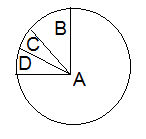Which of the following has maximum global biodiversity?
1. Angiosperms
2. Algae
3. Lichens
4. Mosses
1. Angiosperms
2. Algae
3. Lichens
4. Mosses
What is applicable to both Lates niloticus and Lantana camara ?
1. They are on the verge of extinction due to over-exploitation by humans.
2. They are alien species that became invasive in certain environments causing threat to indigenous biodiversity.
3. They are mutualists and likely to undergo co-extinction in recent future.
4. They are keystone species and are vital to the stability of tropical ecosystems.
Givenbelow is the representation of the extent of global diversity of invertebrates. What groups the four portions (A-D) represent respectively ?

A B C D
(1) insects Crustaceans Other animal Molluscs
(2) Insects Other animal groups Crustaceans Molluscs
(3) Molluscs Other animal groups Crustaceans Insects
(4) Insects Molluscs Crustaceans Other animal groups
The term "The Evil Quartet" is related with:
(1) Four major causes of forest loss
(2) Four major causes of population explosion
(3) Four major causes of air pollution
(4) Four major causes of biodiversity losses
Given below are pie diagrams A, B and C related to proportionate number of species of major taxa of invertebrates, vertebrates and plants respectively. Critically study and fill in the blanks I, II, III and IV:
(1) I - Molluscs, II - Amphibians, III - Fungi, IV - Angiosperms
(2) I - Molluscs, II - Amphibians, III - Angiosperms, IV - Fungi
(3) I - Hexapoda, II - Amphibians, III - Fungi, IV - Angiosperms
(4) I - Turtles, II - Amphibians, III - Fungi, IV - Angiosperms
Conservation hotspots are best described as:
(1) Areas with large numbers of endemic species that are disappearing rapidly
(2) Areas where people are particularly active supporters of biological diversity
(3) Islands that are experiencing high rates of extinction
(4) Areas where native species are being replaced with introduced species
One of the following statements is incorrect with reference to biodiversity. Identify it:
1. The richest reservoirs of animal and plant life (high species richness) with few or no threatened species are called 'biodiversity hotspots’
2. Biodiversity increases from higher altitudes to lower altitudes
3. Biodiversity decreases from the equator to polar regions
4. Depletion in genetic diversity of crop plants is mainly due to the introduction of better varieties with high yield, disease resistance, etc.
In situ strategies include-
- Biosphere reserve B. National park
- Wildlife sanctuaries D. Sacred forests / lakes
(1) A, B
(2) A, B, C
(3) B, C, D
(4) A, B, C, D
Ex situ strategies include:
- Botanical garden B. Zoos
- Seed / Pollen banks D. Gene bank and tissue culture
(1) A, B
(2) A, B, C
(3) B, C, D
(4) A, B, C, D
According to the concept of species area relations:
(1) The number of species in an area increases with the size of the area
(2) Larger species require larger habitat areas than do smaller species
(3) Most species within any given area are endemic
(4) The larger the area, the greater the extinction rate







